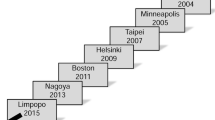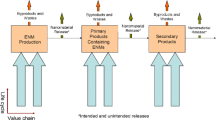Abstract
A concerted effort is being made to insert Prevention through Design principles into discussions of sustainability, occupational safety and health, and green chemistry related to nanotechnology. Prevention through Design is a set of principles, which includes solutions to design out potential hazards in nanomanufacturing including the design of nanomaterials, and strategies to eliminate exposures and minimize risks that may be related to the manufacturing processes and equipment at various stages of the lifecycle of an engineered nanomaterial.






Similar content being viewed by others
References
AIHA (2008) Demonstrating the business value of industrial hygiene
Albanese A, Tang PS, Chan WCW (2012) The effect of nanoparticle size, shape, and surface chemistry on biological systems. Annu Rev Biomed Eng 14: 1–16
ANSI A, ASSE (2012) Z10-2012 occupational health & safety management systems. American Society of Safety Engineers, Park Ridge
Baisch BL, Corson NM, Wade-Mercer P, Gelein R, Kennell AJ, Oberdörster G, Elder A (2014) Equivalent titanium dioxide nanoparticle deposition by intratracheal instillation and whole body inhalation: the effect of dose rate on acute respiratory tract inflammation. Part Fibre Toxicol 11(1):5
Berg JM, Romoser A, Banerjee N, Zebda R, Sayes CM (2009) The relationship between ph and zeta potential of ~30 nm metal oxide nanoparticle suspensions relevant to in vitro toxicological evaluations. Nanotoxicology 3(4):276–283
Brouwer DH (2012) Control banding approaches for nanomaterials. Ann Occup Hyg 56(5):506–514
Castranova V (2011) Overview of current toxicological knowledge of engineered nanoparticles. J Occup Environ Med 53:S14–S17
Dahm MM, Yencken MS, Schubauer-Berigan MK (2011) Exposure control strategies in the carbonaceous nanomaterial industry. J Occup Environ Med 53(6S):S68–S73
Eastlake A, Hodson L, Geraci C, Crawford C (2012) A critical evaluation of material safety data sheets (msdss) for engineered nanomaterials. J Chem Health Saf 19(5):1–8
Environmental Defense Fund, Dupont (2007) Nano risk framework. Environmental Defense, New York
Gangwal S, Brown JS, Wang A, Houck KA, Dix DJ, Kavlock RJ, Hubal EAC (2011) Informing selection of nanomaterial concentrations for toxcast in vitro testing based on occupational exposure potential. Environ Health Perspect 119(11):1539–1546
Harper SL, Carriere JL, Miller JM, Hutchison JE, Maddux BL, Tanguay RL (2011) Systematic evaluation of nanomaterial toxicity: utility of standardized materials and rapid assays. ACS Nano 5(6):4688–4697
Hubbs A, Mercer R, Coad J, Battelli L, Willard P, Sriram K, Wolfarth M, Castranova V, Porter D (2009) Persistent pulmonary inflammation, airway mucous metaplasia and migration of multiwalled carbon nanotubes from the lung after subchronic exposure. Toxicologist 108(1):457
ISO (2004) 14000 environmental management. International Standards Organization, Geneva
ISO (2005) Iso/tc 229 nanotechnologies. I. O. f. S. T. Committee (ed) Geneva
ISO (2008) 9001 quality management systems. International Standards Organization, Geneva
ISO (2012) Standard iso/tr 13329:2012 nanomaterials—preparation of material safety data sheet. International Standards Organization, Geneva
Johnson D, Kennedy AJ, Steevens JA, Methner MM (2009) Enhanced occupational exposure to nanomaterials when mixed in environmentally-relevant matrices. Toxicologist 108(1):460
Kim SC, Chen DR, Qi C, Gelein RM, Finkelstein JN, Elder A, Bentley K, Oberdörster G, Pui DYH (2010) A nanoparticle dispersion method for in vitro and in vivo nanotoxicity study. Nanotoxicology 4(1):42–51. doi:10.3109/17435390903374019
Kreiss K (2012) Respiratory disease among flavoring-exposed workers in food and flavoring manufacture. Clin Pulm Med 19(4):165–173
Kuempel ED (2011) Carbon nanotube risk assessment: implications for exposure and medical monitoring. J Occup Environ Med 53:S91–S97. doi:10.1097/JOM.0b013e31821b1f3f. Available from http://journals.lww.com/joem/Fulltext/2011/06001/Carbon_Nanotube_Risk_Assessment__Implications_for.21.aspx
Kuempel E, Castranova V, Geraci C, Schulte P (2012) Development of risk-based nanomaterial groups for occupational exposure control. J Nanopart Res 14(9):1–15
Leith D, Miller-Lionberg D, Casuccio G, Lersch T, Lentz H, Marchese A, Volckens J (2013) Development of a transfer function for a personal, thermophoretic nanoparticle sampler. Aerosol Sci Technol 48(1):81–89. doi:10.1080/02786826.2013.861593. Available from http://dx.doi.org/10.1080/02786826.2013.861593. Accessed 09 Oct 2014
Li N, Xia T, Nel AE (2008) The role of oxidative stress in ambient particulate matter-induced lung diseases and its implications in the toxicity of engineered nanoparticles. Free Radic Biol Med 44(9):1689–1699. doi:10.1016/j.freeradbiomed.2008.01.028. Available from http://www.sciencedirect.com/science/article/pii/S0891584908000713.
Liu J, Sonshine DA, Shervani S, Hurt RH (2010) Controlled release of biologically active silver from nanosilver surfaces. ACS Nano 4(11):6903–6913. doi:10.1021/nn102272n. Available from http://dx.doi.org/10.1021/nn102272n. Accessed 07 Oct 2014.
Ma JY, Mercer RR, Barger M, Schwegler-Berry D, Scabilloni J, Ma JK, Castranova V (2012) Induction of pulmonary fibrosis by cerium oxide nanoparticles. Toxicol Appl Pharmacol 262(3):255–264
Mandrell D, Truong L, Jephson C, Sarker MR, Moore A, Lang C, Simonich MT, Tanguay RL (2012) Automated zebrafish chorion removal and single embryo placement: optimizing throughput of zebrafish developmental toxicity screens. J Lab Autom 17(1):66–74. Available from http://jla.sagepub.com/content/17/1/66.abstract. doi:10.1177/2211068211432197. Available from http://jla.sagepub.com/content/17/1/66.abstract.
Methner M, Hodson L, Geraci C (2010) Nanoparticle emission assessment technique (neat) for the identification and measurement of potential inhalation exposure to engineered nanomaterials—part A. J Occup Environ Hyg 7(3):127–132
NIOSH (2009) Approaches to safe nanotechnology: managing the health and safety concerns associated with engineered nanomaterials. U.S. Department of Health and Human Services, Centers for Disease Control and Prevention, National Institute for Occupational Safety and Health (ed) Cincinnati
NIOSH (2010) Prevention through design: plan for the national initiative. HHS Centers for Disease Control and Prevention, National Institute for Occupational Safety and Health, Cincinnati
NIOSH (2011) Current intelligence bulletin 63: Occupational exposure to titanium dioxide. U.S. Department of Health and Human Services, Centers for Disease Control and Prevention, National Institute for Occupational Safety and Health (ed) Cincinnati
NIOSH (2013) Current intelligence bulletin 65: Occupational exposure to carbon nanotubes and nanofibers. U.S. Department of Health and Human Services, Centers for Disease Control and Prevention, National Institute for Occupational Safety and Health (ed) Cincinnati
Oberdörster G, Sharp Z, Atudorei V, Elder A, Gelein R, Kreyling W, Cox C (2004) Translocation of inhaled ultrafine particles to the brain. Inhal Toxicol 16(6–7):437–445. doi:10.1080/08958370490439597. Available from http://informahealthcare.com/doi/abs/10.1080/08958370490439597.
OSHA (2012) Hazard communication. O. S. a. H. Adminstration (ed) [Federal Register Volume 77, Number 58 (Monday, March 26, 2012)
Peterson J (1973) Principles for controlling the occupational environment. The industrial environment—its evaluation and control pp 74–117
Porter DW, Hubbs AF, Mercer RR, Wu N, Wolfarth MG, Sriram K, Leonard S, Battelli L, Schwegler-Berry D, Friend S, Andrew M, Chen BT, Tsuruoka S, Endo M, Castranova V (2010) Mouse pulmonary dose- and time course-responses induced by exposure to multi-walled carbon nanotubes. Toxicology 269(2–3):136–147. Available from http://www.sciencedirect.com/science/article/pii/S0300483X09005216. doi:10.1016/j.tox.2009.10.017
Roussel C, Connor T (2014) Chemotherapy: current and emerging issues in safe handling of antineoplastic and other hazardous drugs. Oncol Pharm 7(3):8–11. Available from http://theoncologypharmacist.com/top-issues/2014-issues/august-2014-vol-7-no-3
Sager TM, Wolfarth MW, Andrew M, Hubbs A, Friend S, Chen TH, Porter DW, Wu N, Yang F, Hamilton RF, Holian A (2014) Effect of multi-walled carbon nanotube surface modification on bioactivity in the c57bl/6 mouse model. Nanotoxicology 8(3):317–327. doi:10.3109/17435390.2013.779757. Available from http://informahealthcare.com/doi/abs/10.3109/17435390.2013.779757.
Sanchez VC, Jachak A, Hurt RH, Kane AB (2011) Biological interactions of graphene-family nanomaterials: an interdisciplinary review. Chem Res Toxicol 25(1):15–34. doi:10.1021/tx200339h. Available from http://dx.doi.org/10.1021/tx200339h. Accessed 08 Oct 2014.
Schubauer-Berigan MK, Dahm MM, Yencken MS (2011) Engineered carbonaceous nanomaterials manufacturers in the United States: workforce size, characteristics, and feasibility of epidemiologic studies. J Occup Environ Med 53(6S):S62–S67
Schulte P, Geraci C, Zumwalde R, Hoover M, Kuempel E (2008a) Occupational risk management of engineered nanoparticles. J Occup Environ Hyg 5(4):239–249. doi:10.1080/15459620801907840. Available from http://dx.doi.org/10.1080/15459620801907840. Accessed 01 April 2015.
Schulte PA, Rinehart R, Okun A, Geraci CL, Heidel DS (2008b) National prevention through design (ptd) initiative. J Saf Res 39(2):115–121
Schulte P, Geraci C, Murashov V, Kuempel E, Zumwalde R, Castranova V, Hoover M, Hodson L, Martinez K (2014) Occupational safety and health criteria for responsible development of nanotechnology. J Nanopart Res 16(1):1–17
Shaffer R, Rengasamy S (2009) Respiratory protection against airborne nanoparticles: a review. J Nanopart Res 11(7):1661–1672. doi:10.1007/s11051-009-9649-3. Available from http://dx.doi.org/10.1007/s11051-009-9649-3.
Shi X, von Dem Bussche A, Hurt RH, Kane AB, Gao H (2011) Cell entry of one-dimensional nanomaterials occurs by tip recognition and rotation. Nat Nanotechnol 6(11):714–719
Shvedova AA, Kisin E, Murray AR, Johnson VJ, Gorelik O, Arepalli S, Hubbs AF, Mercer RR, Keohavong P, Sussman N, Jin J, Yin J, Stone S, Chen BT, Deye G, Maynard A, Castranova V, Baron PA, Kagan VE (2008) Inhalation vs. aspiration of single-walled carbon nanotubes in c57bl/6 mice: inflammation, fibrosis, oxidative stress, and mutagenesis
Tsai CS (2015) Contamination and release of nanomaterials associated with the use of personal protective clothing. Ann Occup Hyg. doi:10.1093/annhyg/meu111
Tsai S-JC, Huang RF, Ellenbecker MJ (2010) Airborne nanoparticle exposures while using constant-flow, constant-velocity, and air-curtain-isolated fume hoods. Ann Occup Hyg 54(1):78–87
Turkevich LA, Dastidar AG, Hachmeister Z, Lim M (2015) Potential explosion hazard of carbonaceous nanoparticles: explosion parameters of selected materials. J Hazard Mater 15(295):97–103
Acknowledgments
The authors express their gratitude to all of the participants at the Safe Nano Design conference.
Disclaimer
The findings and conclusions in this report are those of the author(s) and do not necessarily represent the views of the National Institute for Occupational Safety and Health.
Author information
Authors and Affiliations
Corresponding author
Additional information
Christie Sayes previously with RTI International, Research Triangle Park, NC, USA
Rights and permissions
About this article
Cite this article
Geraci, C., Heidel, D., Sayes, C. et al. Perspectives on the design of safer nanomaterials and manufacturing processes. J Nanopart Res 17, 366 (2015). https://doi.org/10.1007/s11051-015-3152-9
Received:
Accepted:
Published:
DOI: https://doi.org/10.1007/s11051-015-3152-9




